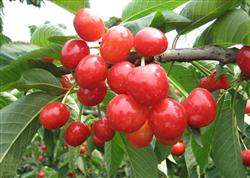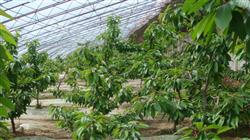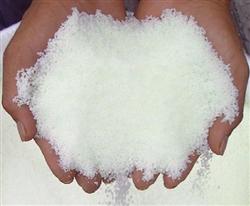Cherry tree planting: Cherry cultivation picture video

Cherry can be sold in late spring and early summer. It is the earliest fruit tree in Yangtze River Basin and Huaibei area. The fruit growth period is short, only 40~60 days from flowering to harvest, the field management work is light, and the production cost is low. Cherry fruit color is gorgeous, delicious, rich in iron, in addition to fresh food, can be used for dessert embellishment or senior banquet, but also processed into canned sugar water, preserved fruit, fruit juice and other products. Especially sweet cherry, fruit is big, flesh is thick, hardness is big, especially suitable for processing, domestic and foreign market demand is large, the price is high, but at present domestic planting area is small, there is high development value in Huaibei area. Dwarf cherry and Chinese cherry have smaller plants, early fruiting and long life span, and are also suitable for courtyard cultivation and greenhouse cultivation. Main species and varieties of cherry Cherry is a plant belonging to the genus Prunus of Rosaceae. There are three main kinds of fruit trees cultivated in production: Chinese cherry, European sweet cherry (sweet cherry for short) and European sour cherry (sour cherry for short). The fine varieties of Chinese cherries include Jinhong cherry and big eagle cherry in Taihe, Anhui Province, Dawolou leaf in Zaozhuang, Shandong Province, Dahong cherry in Tengxian County, Dongtang cherry in Nanjing, Jiangsu Province, short-stemmed cherry in Zhuji, Zhejiang Province, etc. Sweet cherry varieties are purple, red cherry, Reni, Sato Jin, Na Weng, red light, Hongyan, Jiahong, Juhong, Bin Ku and so on. Sour cherry varieties sour taste, mainly for processing, it is barren, cold, late flowering, sweet cherry is also a good rootstock. Growth and fruiting habits of cherries Cherry root growth requires strict permeability of soil, and root distribution becomes shallow obviously when clay soil or soil management is poor, which leads to premature senescence of shoot. Chinese cherry tree growth is weak, mostly medium and small trees or shrubby crown. Sweet cherry dry strong, vigorous growth, for tall trees. Sour cherry trees are shrubs or small trees. The germination rate of Chinese cherry was higher than that of sweet cherry, and almost all buds of the former could germinate at germination, while the number and life span of hidden buds of sweet cherry were more and longer than those of Chinese cherry, which was the basis of large branch regeneration in later stage. Branching ability varies according to species and varieties, Chinese cherry is generally stronger than sweet cherry. Branching ability decreased obviously with age. Annual branches can be divided into two types: growing branches and fruiting branches. After entering the fruiting period, the growth of branches becomes smaller. Branches that were originally growing branches (such as extended branches of backbone branches at all levels) often form flower buds at the base and leaf buds in the middle and upper parts. Some people call it mixed branches. These branches have the triple function of enlarging crown, forming new fruit branches and flowering. Other fruiting branches can be divided into 4 types: long fruiting branch, medium fruiting branch, short fruiting branch and bouquet fruiting branch. Generally, species and varieties with strong branching ability play an important role in yield formation from early fruit stage to early full fruit stage. On the contrary, the varieties with weak branching ability or the big trees in full fruit stage mainly form yield by bouquet fruit branches and short fruit branches. Cherry and other stone fruit trees are different in that the flower buds on the long fruit branches are mostly single at the base and lower part of the branches, and few compound buds exist, so the part is bare after flowering. Short fruit branch and bouquet fruit branch are the main fruit branch types of sweet cherry varieties because of their strong bearing strength, long life span, continuous single axis extension and fruit bearing for many years. There are 1~5 flowers in a flower bud, which are racemes or clustered. Most varieties of Chinese cherry can self-flower and bear fruit, most sweet cherry varieties are cross-flower and bear fruit, which need to be pollinated, and sometimes cross-pollination incompatibility occurs. However, in recent years, China has introduced some excellent varieties such as Steinle and Rabins, which can self-flower and bear fruit and are more resistant to cracking fruit. Cherry fruit development is short, like peach, with two rapid growth and a stone hardening stagnate growth. Flesh has soft flesh and hard flesh two kinds, the flesh is crisp hard variety is generally more resistant to storage and transportation. Cultivation techniques of cherry trees 1. Propagation and planting of cherry trees Chinese cherry shoots have strong rooting ability, and the survival rate can generally reach 80%~90% by cutting propagation. Cuttings should be made from annual branches before sap flow in spring. The cuttings are 15 cm ~20 cm long, buried 2/3, and then covered with soil to be level with the upper opening of the cuttings or 1 cm ~2 cm high. A small number of seedlings can be used when the sub-plant or layering method. Sweet cherries must be propagated by grafting. Grass cherry (a type of Chinese cherry with strong affinity with sweet cherry) is used for rootstock water, and other green cherry, sour cherry and mahali cherry can be used. The latter two rootstocks had dwarfing effect. Chinese cherries have strong adaptability and can be planted in Jianghuai area. Sweet cherry adaptability is poor, the temperature and humidity in the south of Huaihe River is high, it is not suitable for planting; otherwise, it is easy to cause excessive growth of branches and leaves, poor results, and the ripening period is the plum rain season, but also easy to cause cracking and fruit rot. The ideal soil is a loam soil with good ventilation and drainage and moisture retention. The planting ground shall be chosen for frost and for shelter. Sweet cherry planting should select good pollinating trees and plant them at the same time. When Naweng and Binku were the main varieties, they could be pollinated with topaz, dazi and zaozi; when Hongdeng and dazi were the main varieties, they could be pollinated with Naweng and topaz. However, the two varieties showed incompatibility after pollination. The two varieties, Hanghong and Juhong, could pollinate each other. In addition, Steiner and Rabins were good pollinators with strong pollen compatibility. Pollinating trees generally account for 30% to 40%. For canning sweet cherries should also be selected large fruit, hard flesh yellow varieties, such as naweng, banana, reni and so on. Seedlings can be planted in autumn or spring. After planting, immediately irrigate once permeable water, and cultivate soil to preserve moisture, or cover the tree tray with plastic film, which is conducive to improving the survival rate of planting and early growth of plants. Plant spacing varies according to crown size. Chinese cherry crown is small, generally master 4 meters ~5 meters, sweet cherry crown is larger, should be 4 meters ~6 meters. In barren land or dwarfing cultivation, the plant spacing can be reduced appropriately. 2. Pruning cherry trees Chinese cherry dry not strong and branch more, generally more natural cluster tree shape. Without trunk or trunk is very short, cultivate 4~5 oblique main branches from near ground, cut short and enlarge crown in winter, and select auxiliary main branches (lateral branches). The young shoots in the growth period can be picked early (before June) to promote secondary branches and accelerate the formation of crown. The plastic surgery can be completed within three years. Sweet cherry is stronger in sex, and is generally considered to be a natural open-heart or natural clump tree that forms quickly, prunes lightly, bears early, and is suitable for dense planting. The former tree shaping process can refer to peach. In addition, dry strong, stratified varieties (such as Naweng) can also be used to disperse stratified tree shape. But this kind of tree body is tall, management is inconvenient, and because pruning amount is large, often delay the fruit. If dwarfing rootstock is used, the tree structure can be simplified, and the tree shape of free spindle or trunk can be adopted to accelerate the formation. In order to promote early fruiting and early high yield of young trees, except for short trunk branches according to plastic requirements, the rest of the branches with moderate growth should be released slowly to promote the formation of medium and short fruit branches and early fruiting. Upright branches and over-dense branches need to be thinned out. Small angle branches should be adjusted during the growth period. In full fruiting period, 2~3 year old branches with short fruiting branches and bouquet fruiting branches should be retracted properly to stimulate vegetative growth and formation of new fruiting branches, delay senescence of fruiting branches and outward movement of fruiting parts. 3. Soil, fertilizer and water management of cherry trees and control of growth and flower promotion Cherry root system distribution is shallow, especially sweet cherry with age growth, often vulnerable to drought, wind damage and freezing injury, planting after the need to deepen the soil year after year, deepen the distribution of roots. Fertilization according to the cherry flower growth period early and short characteristics, should be post-harvest fertilizer and pre-winter base fertilizer mainly to promote flower bud differentiation, increase tree storage nutrition. In addition, suitable topdressing (mainly available nitrogen fertilizer) and topdressing outside roots (spraying 0.1%~0.3% urea or 600 times potassium dihydrogen phosphate) during flowering and fruiting period have obvious effects on increasing fruiting rate and promoting branch growth. Soil water shortage often causes cherry fruit drop, from flowering to pre-harvest such as drought, should be appropriate irrigation. Cherry newspaper line on the soil ventilation conditions strict requirements, each irrigation should be less, and timely tillage loose soil moisture. Where there is no irrigation condition, trees can be covered with grass to preserve moisture. This is very good for improving cherry fruit set rate and berry quality. After entering the mature period, it is easy to cause fruit cracking due to repeated rainfall. In addition to selecting varieties resistant to fruit cracking and doing well in field drainage, spraying 72% calcium hydroxide or 54% calcium chloride solution on berries 2~3 weeks before harvest and spraying again every 5~7 days can reduce fruit cracking. In coastal windy areas, in order to prevent young trees from lodging, it is necessary to do a good job of cultivating soil, master spring cultivation and autumn harvest, and it is not advisable to cultivate soil around the trunk for a long time. Cherry, especially sweet cherry, young trees are easy to flourish and difficult to form flower buds, and cause large crown. In addition to using dwarfing rootstock to slow down the growth potential, spraying paclobutrazol solution at the concentration of 250ppm~300ppm on the leaves of cherries at the beginning of growth (Chinese cherries can also be harvested) has obvious effects on promoting flower growth and early fruit yield. Cherry tree main diseases and insect pests and their control methods Cherry many diseases and insect pests and other stone fruit trees the same, can refer to the control. The main diseases of cherry are perforation, root neck rot and ooze. Root neck rot occurs mostly in trees at the early fruit stage, causing root neck ulceration. Control methods: mainly to avoid long-term cultivation of soil in the root neck of plants, control underground pests gnawing bark. At the same time, we should check frequently, find sick plants, scrape them in time, and disinfect them with Bordeaux slurry or stone mixture after scraping. If the root neck is seriously rotted, the growth of the shoot can be restored by spring bridging. Cherry pests, mainly red-necked longicorn, golden thread insects, small transparent wing moth, ball hard scale insects and boat caterpillar, etc. Small transparent wing moth 1 generation a year, larvae damage in the cortex of large branches. The main control measures are spraying at the peak of adult emergence, painting white on branches to prevent spawning, and killing or digging out larvae in time when they are found in the field. Click for more cherry tree planting techniques Click for more fruit planting techniques
- Prev

Cherry tree planting: how to fertilize cherries in autumn?
How to fertilize cherries in autumn? Please introduce the method of cherry fertilization cherry tree fertilization can refer to the following methods: cherry young trees under 3 years old are in crown expansion period, vegetative growth is exuberant, need more nitrogen, should be mainly nitrogen fertilizer, auxiliary appropriate amount of phosphate fertilizer, in order to promote crown formation; 3-5 years.
- Next

Planting cherry trees: how to manage them after picking?
How to manage cherries after picking? Please give a detailed introduction of cherry picking can refer to the following methods of management: first, timely topdressing of cherry trees, early application of base fertilizer: after cherry harvest, there is an urgent need to replenish nutrients to the trees, and timely application of quick-acting multi-component compound fertilizer. Generally according to the age and the size of the tree, each tree applies 1.
Related
- Moge, come on! The staff of the peasant association in the producing area of cantaloupe were frightened when the crowd gathered.
- Causes and Solutions of low Fruit setting rate of Apple
- Symptoms and control measures of passion fruit virus disease
- Fruit growing lesson: how do apple orchards keep high yields?
- Can you build orchards in the mountains? What are the pros and cons?
- How to manage the coloring period of Crisson grape?
- This paper introduces the processing technology of two kinds of fig products.
- How much is a month for retired teachers in rural areas by 2020?
- How can strawberry planting increase sugar content? We should pay attention to management in many aspects.
- What are the cultivation techniques on how to improve the yield of golden fruit?

